Growing Food For Christmas: How To Grow Christmas Dinner


You don't have to be vegetarian to want veggies adorning your holiday table. Growing food for Christmas is possible, but it does take some preplanning. Depending upon your zone, garden vegetables for Christmas dinner can take center stage in the meal. Learn how to grow Christmas dinner veggies and then all you need is a turkey or a ham!
What to Grow for a Christmas Dinner Garden
A Christmas dinner garden starts around April or May. Many of the vegetables you will use in your recipes during the holidays will need that long to mature. Others that are cool-season crops can be started midsummer. Think ahead if you want to grow your own Christmas dinner.
There are many traditional recipes we commonly see on our holiday tables. Root vegetables, allium bulbs, and crops from the cole family often feature in our holiday recipes. Let’s not forget cranberries, a must-have condiment for turkey.
Some crops will be ready the day you need them, while others can be held cold for a month or preserved. Crops like onions, garlic, or leeks freeze well and will be ready to lend a hand flavoring your dishes. Plant these:
- Carrots
- Potatoes
- Turnips
- Parsnips
- Brussels Sprouts
- Beets
- Kale
- Cabbage
- Sweet Potatoes or Yams
- Broccoli
- Squash
- Pumpkins
- Herbs
How to Grow Christmas Dinner
If you want garden vegetables for Christmas, pay careful attention to their harvest date on the seed packet. If you tend to experience freezing temperatures in early fall, plant root crops in raised beds. The allium bulbs should be pulled in the fall and allowed to dry. Then store them in a cool, dark location. If you need them at Christmas, chop and freeze them.
Other types of crops may have reached their peak in the summer, but you can still have them for Christmas if you lightly blanch them, freeze them on sheet pans, and bag them up in the freezer. Growing food for Christmas will often include preserved or frozen foods for the best quality and in order to foil freezing weather.
Starting Your Christmas Veggie Plot
Start most of your veggies that will be frozen or preserved in spring after all danger of frost has passed. In cooler regions, start seeds in flats indoors so they are ready to plant out as soon as the soil is warm and no freezing is expected.
Sign up for the Gardening Know How newsletter today and receive a free copy of our e-book "How to Grow Delicious Tomatoes".
Cool-season crops can be started indoors and planted out in April in most zones. Seeded root crops should be in the soil by May at the latest. You can start beans around the same time. They will not be growing in the winter but freeze beautifully.
Potatoes can be planted as late as August and grow through fall. Before it freezes, pull all the taters and place them in a cool dark area.
Don't forget the fruits. Cranberries freeze well, as do apples for a pie. Squash and pumpkins keep a long time, or you can cook them and freeze the meat.
With a little forethought, this Christmas dinner will highlight your garden prowess and bring a bit of the warm weather into your home.

Bonnie Grant is a professional landscaper with a Certification in Urban Gardening. She has been gardening and writing for 15 years. A former professional chef, she has a passion for edible landscaping.